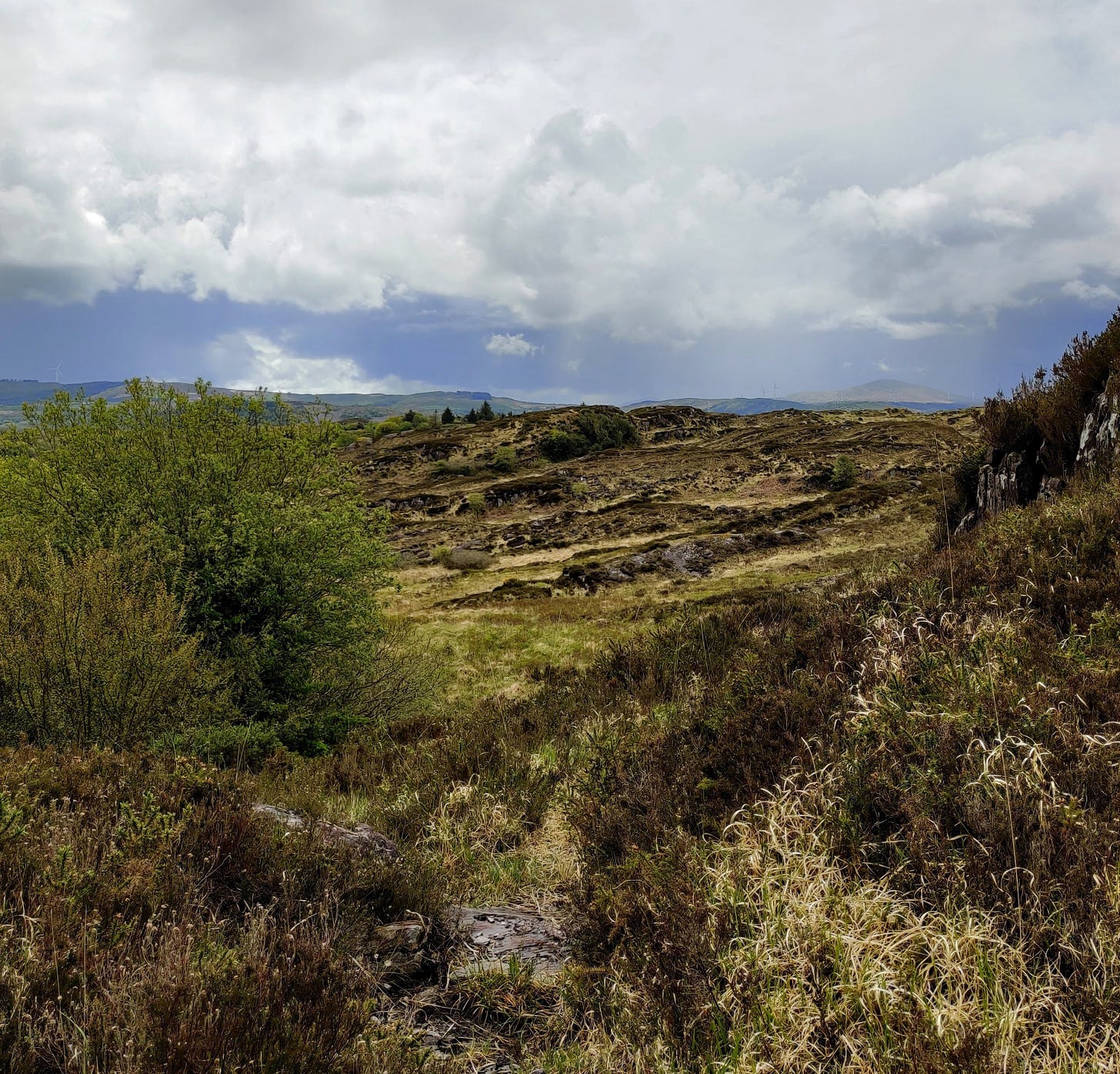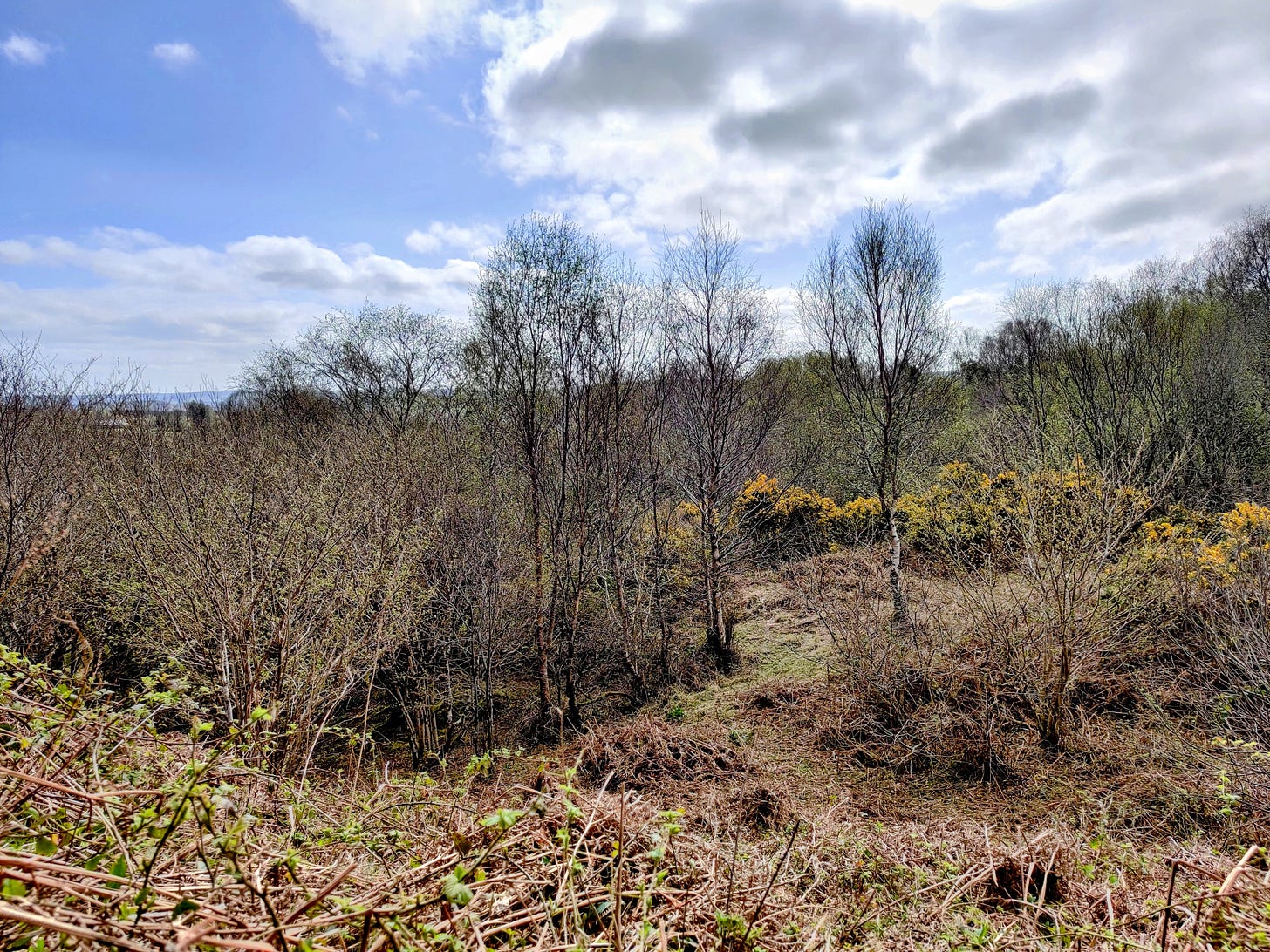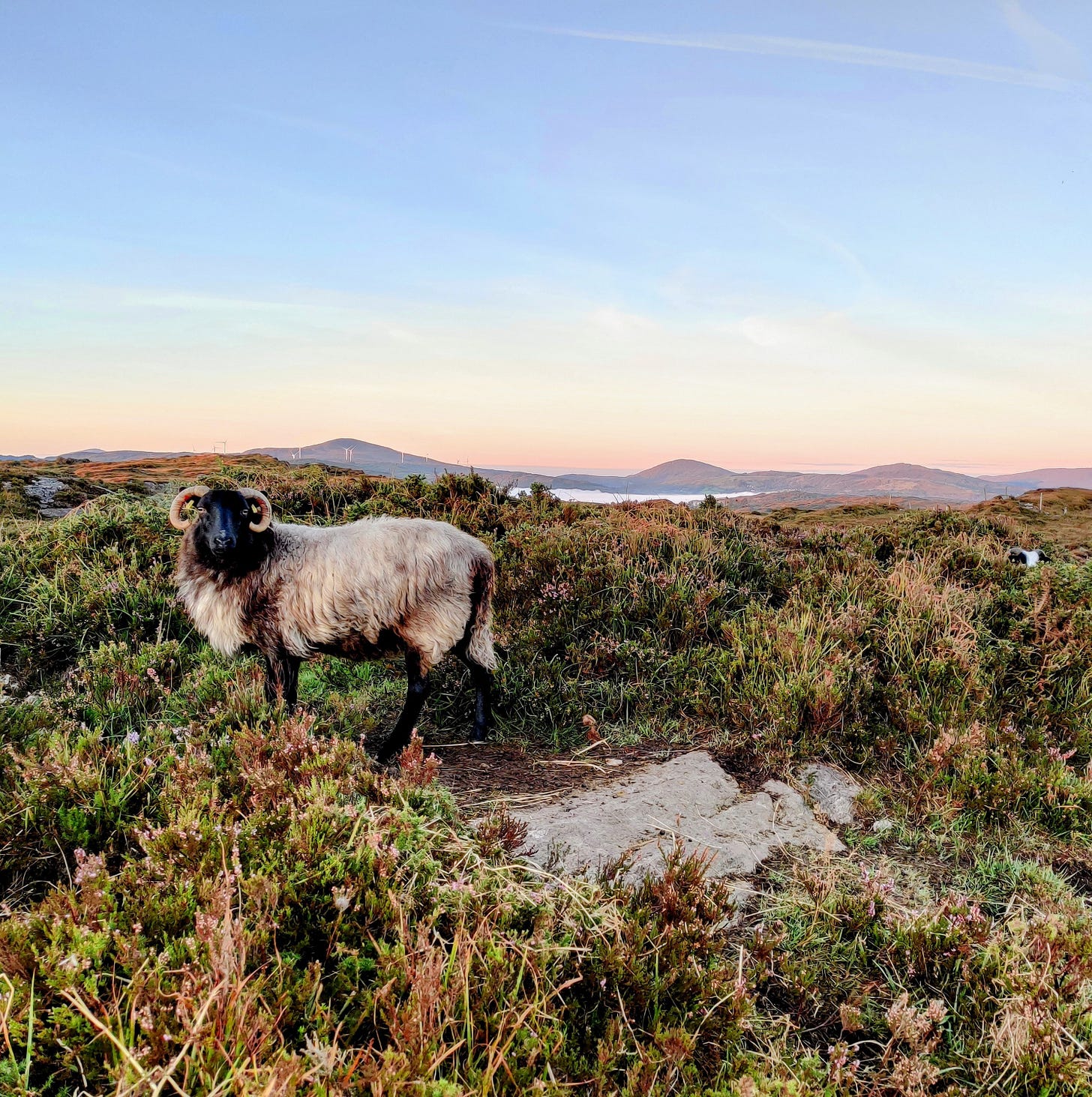Becoming land
Edited 18/10/24
The first time I came here the wildness sang to my soul and I knew that I was home, that I would root into this land and become it. Spring rains had flooded the wetlands and gushing springs burst from the rocks and cascaded down the mountain. Hares raced across the heath. The strip of land I had come to walk seemed to stretch forever in undulating terrain, every windswept ridge of exposed rock giving way to a sloping meadow of wild highland grasses and heavily scented bog myrtle that filled the air as I brushed by, with pockets of willow, holly and mountain ash huddling in the shelter of dips and cliff hollows.
I came here often through that first year. I watched the seasons unfold across the mountains, drawn to the land as though it called to every strand of my being. Spring floods gave way to dry heath. Bog bean, asphodel, butterwort and fluffy white balls of cotton grass bounced on the breeze and the barren brown mountaintop woken by summer warmth erupted into green. Spotted orchids bloomed then faded. The heather burst into a blaze of pink across hilltops splashed with golden gorse and buzzing with the busyness of bumblebees. And finally, the scabious bloomed, turning the wet meadows into bobbing seas of blue.
That was three full cycles of the sun and some moons ago as I write this now, and I knew then that it wouldn’t be easy, that this would be so much more than just land to farm. It would be a life’s work; a lifetime project of restoring fertile green to carve out a living on the land while treading gently as I walk with the wild. This is rough mountain land in the hills of the southwestern corner of Ireland: bog, heath and rock. No plough has turned this peaty sod—not many crops would grow up here anyway. Only sheep, deer and mountain hares survive on the scrub and wild grasses that brave this exposure and thrive in the shallow soil. Perhaps I’m crazy to try.
As wild and indigenous as this open landscape appears, it has not always been this way. Temperate rainforest once clothed these hills. The natural vegetation of Ireland was mostly woodland; forests of oak, birch, hazel, willow, rowan and pine climbed the slopes, until succeeded by the gradual expansion of human activity since the arrival of Neolithic farmers and their livestock onto the island of Ireland some six thousand years ago, and the concurrent spread of blanket bog as the climate warmed, until, by recent centuries, only pockets of old woodland remained.
So, those forests are long gone, for better or for worse, and in their place are wetlands, heaths and grasslands that have become home and haven to hares, curlew, orchids, fritillaries, grasshoppers, frogs, butterworts, bumblebees…a plethora of species that depend upon the open meadows and hills, as well as the domestic animals that graze and maintain them.
It is easy to imagine that, left alone for long enough, something reminiscent of those ancient forests might, eventually, regenerate. We see signs of it in the valleys and creeks where willow spreads its roots into the damp soil at the stream’s edge and birch bravely marches up the hill, paving the way for great oaks to follow. But, where the land has been left to run feral, we also see the debris of human disturbance and abandonment that run through the land like the crumbling stone walls of our boundary. Like the cotoneaster, a garden escape, that competes with our native willow for the same damp soil and provides dense cover and berries for the birds, and the European gorse, introduced as livestock fodder, that crowds out the birch saplings and feeds the bees. The open grasslands, without their grazers, are now rank and tangled with un-grazable moor grass that smothers the land, and tracts of bracken run rampant, unchecked by the woods that once stood here but filling a niche and covering soil. Higher up, exposed, degraded and eroded soils that hold no life but the creeping tendrils of bug and root as they crawl up to fill the void. Balance was disturbed, but nature will always find a way to restore it, incorporating and adapting each species, each season, each passing breeze into a new equilibrium on a successional continuum of growth, decay and renewal. Nothing will ever remain the same, or go back to how it was.
I sit in awe of the wildness of this feral land and I don’t want to change a thing, but I also know change is inevitable—change is the only constant the earth knows and the land will continue to respond and adjust to disturbance and climate—with or without us. Some might argue we’ve had our turn, step back and let nature take its own course, but that doesn’t bode well with me. When I press my palm against the wizened skin of the old oak, feel its thrum of life pulsating, rest beneath its shelter on a rock cushioned with saxifrage until the wind chills my bones and the stillness of the earth settles into me, and the earth, the oak and the willows speak to me as clearly as the harvest moon on a bright, still night—for are we not Nature, too?
My aim here is to find a balance with the existing ecology whilst regenerating the land so that it might once more bloom green with abundance and support more life—including ours. To bring our own objective into the cycle of succession with awareness of the changes we effect, as that is both the gift and the curse of being human in this spiralling dance of life—to use our agency as a keystone species consciously, to impact the landscape and its ecosystems with awareness of the power we wield and the responsibility of it, but also of our own fragile interdependence in the great web of all life. Our mortal insignificance as just another infinitesimal incarnation of stardust, a momentary spark of atoms colliding on a trajectory of something far, far greater than us, that will be here long after all trace of our existence is resorbed, incorporated back into the Earth. Out on the land, immersed in the humming of the bees and the bleating of the sheep, there is no separation of us from the rest. We are not in nature—we are nature, nothing more, and nothing less.
There is no denying that our rise to become the most dominant and successful species on Earth has been on the downfall of many others, and that the scale of our success may well be our own downfall. But, as a wise woman once asked, could it be that the true mark of intelligence in a species is its ability to recognise the interconnectedness of all life? Since the very beginning, human, land and livestock have co-evolved, and as we move now beyond the paradigms of the modern era of industrialism that have brought us to a pivotal point in the succession of our species, how we integrate our livestock, our farming systems and ourselves into the landscape and its ecosystems can either continue on a path of extraction that separates and destroys, or bring us back onto a path of reconnection. Of remembering our place on the land, our place as co-creators of our landscape.
Our livestock are as integral now as they were to those pioneering first farmers, to our custody of the land and our livelihood, giving us the means to live on the land by upcycling tough, inedible vegetation into useable fibre and food; and our co-creators, restoring fertility and abundant soils for future generations in that age old cycle of nutrient exchange, disturbance and renewal. Another interdependent element of a dynamic synergy of life supporting more life—including us, as we too, are part of that cycle. We take care of the land, and the land takes care of us. There is nothing else.
And so I sit, listening to the cuckoo call, the munching of the sheep and the soft patter of rain, noting the impacts we and our grazers are making, observing the flow of the seasons and the changes as the land adjusts to our disturbance and the changing climate. When the first orchids bloom and the heather ignites from those early sparks of colour into a royal blaze across the hill; where baby oaks pop up from acorns dropped by birds onto the grassy heath from the wooded creek below; and the subtle transition of species and shade of green as the grasslands respond to the giving and taking of the sheep and begin to change from tough and inedible to sweet and diverse, as land and livestock and I become one, each feeding the other in a symbiotic loop of interconnectedness. And so I sit, breathing heather and wild burnet rose and aromatic bog myrtle and mud and cud mingling on the sweet breath of the ruminants as they work their alchemy turning cellulose to soil, breathing mist and moss and petrichor, becoming land.







"... for are we not Nature, too?" This is my favourite line in this lovely essay, Carly. It is all too easy in this world of concrete and metal that we've made to forget that we are neither, but come from the earth as well, and to the earth we will return. Dust to dust, as it were.
And yet, to live and breathe and look on this good earth, and know it so, and long to love it ... to desire such a life as you and I might pine for, is that not a mark of something divine also? What is it that causes the ear to hear the groan of the land, and the heart to groan with it?